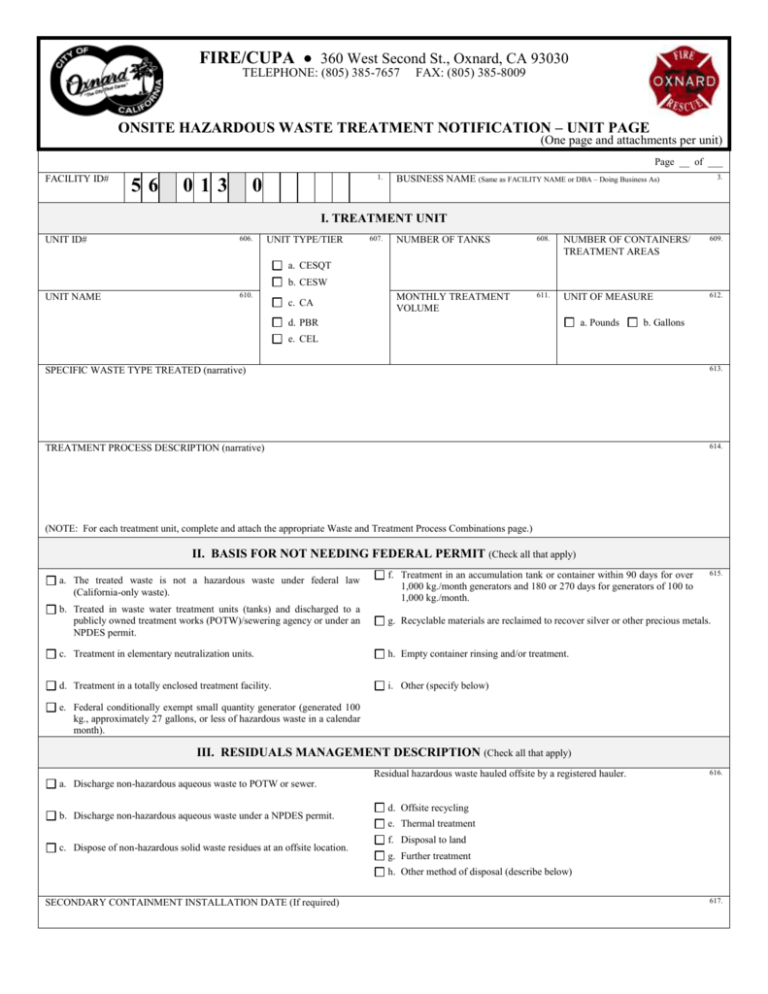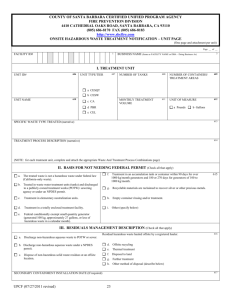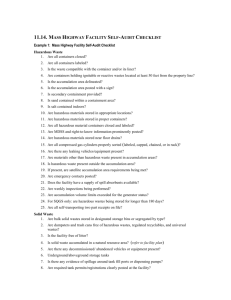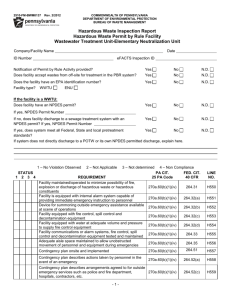Onsite Hazardous Waste Treatment Notification
advertisement

FIRE/CUPA 360 West Second St., Oxnard, CA 93030 TELEPHONE: (805) 385-7657 FAX: (805) 385-8009 ONSITE HAZARDOUS WASTE TREATMENT NOTIFICATION – UNIT PAGE (One page and attachments per unit) Page __ of ___ FACILITY ID# 56 013 1. 0 3. BUSINESS NAME (Same as FACILITY NAME or DBA – Doing Business As) I. TREATMENT UNIT UNIT ID# 606. UNIT TYPE/TIER 607. NUMBER OF TANKS 608. NUMBER OF CONTAINERS/ TREATMENT AREAS 609. MONTHLY TREATMENT VOLUME 611. UNIT OF MEASURE 612. a. CESQT b. CESW UNIT NAME 610. c. CA d. PBR a. Pounds b. Gallons e. CEL SPECIFIC WASTE TYPE TREATED (narrative) 613. TREATMENT PROCESS DESCRIPTION (narrative) 614. (NOTE: For each treatment unit, complete and attach the appropriate Waste and Treatment Process Combinations page.) II. BASIS FOR NOT NEEDING FEDERAL PERMIT (Check all that apply) 615. a. The treated waste is not a hazardous waste under federal law (California-only waste). f. Treatment in an accumulation tank or container within 90 days for over 1,000 kg./month generators and 180 or 270 days for generators of 100 to 1,000 kg./month. b. Treated in waste water treatment units (tanks) and discharged to a publicly owned treatment works (POTW)/sewering agency or under an NPDES permit. g. Recyclable materials are reclaimed to recover silver or other precious metals. c. Treatment in elementary neutralization units. h. Empty container rinsing and/or treatment. d. Treatment in a totally enclosed treatment facility. i. Other (specify below) e. Federal conditionally exempt small quantity generator (generated 100 kg., approximately 27 gallons, or less of hazardous waste in a calendar month). III. RESIDUALS MANAGEMENT DESCRIPTION (Check all that apply) Residual hazardous waste hauled offsite by a registered hauler. 616. a. Discharge non-hazardous aqueous waste to POTW or sewer. b. Discharge non-hazardous aqueous waste under a NPDES permit. c. Dispose of non-hazardous solid waste residues at an offsite location. d. Offsite recycling e. Thermal treatment f. Disposal to land g. Further treatment h. Other method of disposal (describe below) SECONDARY CONTAINMENT INSTALLATION DATE (If required) 617. Onsite Hazardous Waste Treatment Notification – Unit [(Formerly DTSC Form 1772A,B,C,D,L)] Complete an Onsite Hazardous Waste Treatment Notification - Unit page and a Waste and Treatment Process Combinations page for each treatment unit operating at this facility. Commercial Laundries are not required to complete unit specific pages, provided that laundering is the only hazardous waste treatment activity conducted by the facility. Please number all pages of your submittal. (Note: Numbering of these instructions follows the UPCF data element numbers on the form.) 1. 3. 606. 607. 608. 609. 610. 611. 612. 613. 614. 615. 616. 617. FACILITY ID NUMBER - This space is for agency use only. BUSINESS NAME - Enter the complete Facility Name. UNIT ID NUMBER - Enter a unique number for each unit. All unit numbers must be clearly labeled on the plot plan/map. UNIT TYPE / TIER - Check the appropriate box to indicate unit type under the Tiered Permitting program. NUMBER OF TANKS - Enter the number of tanks used in the unit. ["Tank" means a stationary device, designed to contain an accumulation of hazardous waste, which is constructed primarily of non-earthen materials (e.g., wood, concrete, steel, plastic) which provide structural support.] NUMBER OF CONTAINERS/TREATMENT AREAS - Enter the number of containers/container treatment areas used in the unit. ["Container" means any device that is open or closed, and portable in which a material can be stored, handled, treated, transported, disposed of, or recycled.] "Treatment Area" is a location set aside and used to treat waste in containers. UNIT NAME - Enter the name of the treatment unit. A treatment unit is defined as a tank, a container, or a combination of tanks or tank systems and/or containers located together that are used in sequence to treat or accumulate one or more compatible hazardous waste streams. The devices are either plumbed together or otherwise linked so as to form one system. MONTHLY TREATMENT VOLUME - Enter the estimated monthly total volume of hazardous waste treated in this unit. If the volume fluctuates significantly by month, enter the maximum volume treated in any month. UNIT OF MEASURE - Check a box to indicate whether the treatment volume unit of measure is pounds or gallons. SPECIFIC WASTE TYPE TREATED - Describe the specific waste type(s) treated (e.g. If the waste qualifies as an aqueous waste with metals or organics, indicate the specific metals or organics). TREATMENT PROCESS DESCRIPTION - Describe the treatment process(es) used. Indicate if the activities are seasonal or periodic. BASIS FOR NOT NEEDING FEDERAL PERMIT - Check the reason(s) that best describe why your onsite treatment unit does not need a federal hazardous waste permit. You must indicate at least one reason to prove your eligibility for the onsite treatment tiers. If you are unsure how these exemptions apply to your operation, contact your Certified Unified Program Agency (CUPA), the DTSC Regional Office closest to you, the U.S. EPA Region IX RCRA Information Line at (415) 744-2074, or the U.S. EPA RCRA Hotline at (800) 424-9346. The eight most common reasons for not needing a federal permit are listed on this form. There is also a space to specify any other reason for exemption and a supporting regulatory citation. The following terms are defined in 40 CFR §260.10: Wastewater Treatment Unit - A device which: (1) is part of a wastewater treatment facility regulated under section 402 or 307(b) of the Clean Water Act, and (2) receives and treats or stores an influent wastewater that is a hazardous waste or that generates and accumulates a wastewater treatment sludge that is a hazardous waste or that treats or stores a wastewater treatment sludge which is a hazardous waste, and (3) meets the definition of tank or tank system. Elementary Neutralization Unit - A device which (1) is used for neutralizing wastes that are hazardous only because they exhibit the corrosivity characteristic or they are listed only for this reason, and (2) meets the definition of tank, tank system, container, transport vehicle, or vessel. Totally Enclosed Treatment Facility - A facility for the treatment of hazardous waste which is directly connected to an industrial production process and which is constructed and operated in a manner which prevents the release of any hazardous waste or any constituent thereof into the environment during treatment. NPDES Permit - A permit issued by a regional water board allowing discharge of waste to the environment under the National Pollutant Discharge Elimination System (NPDES). RESIDUALS MANAGEMENT DESCRIPTION - Check the appropriate box(es) to describe how treatment residuals are managed. If box h. is checked, describe the "other" methods in the space provided. SECONDARY CONTAINMENT INSTALLATION DATE - Enter the date the secondary containment was installed.









